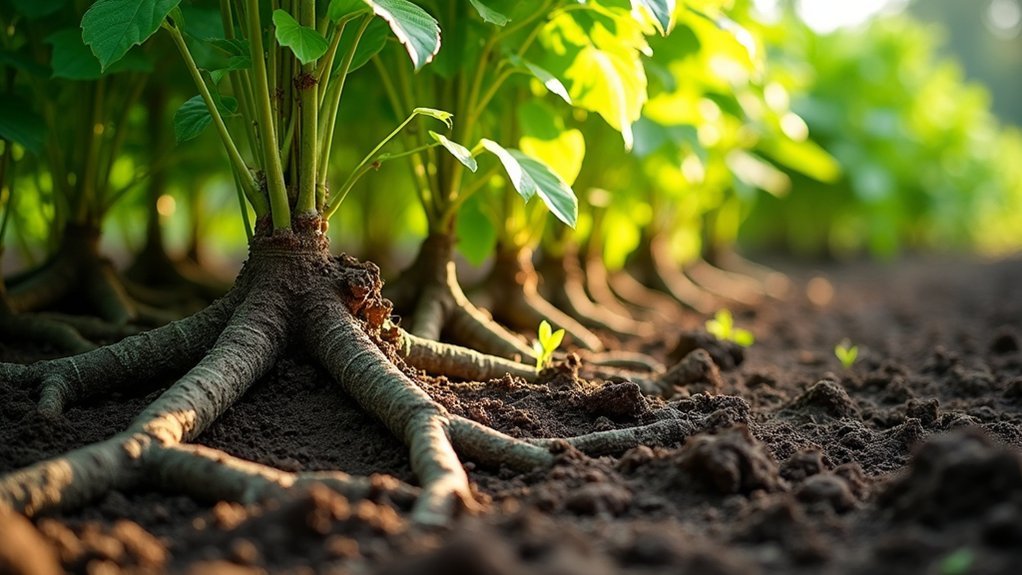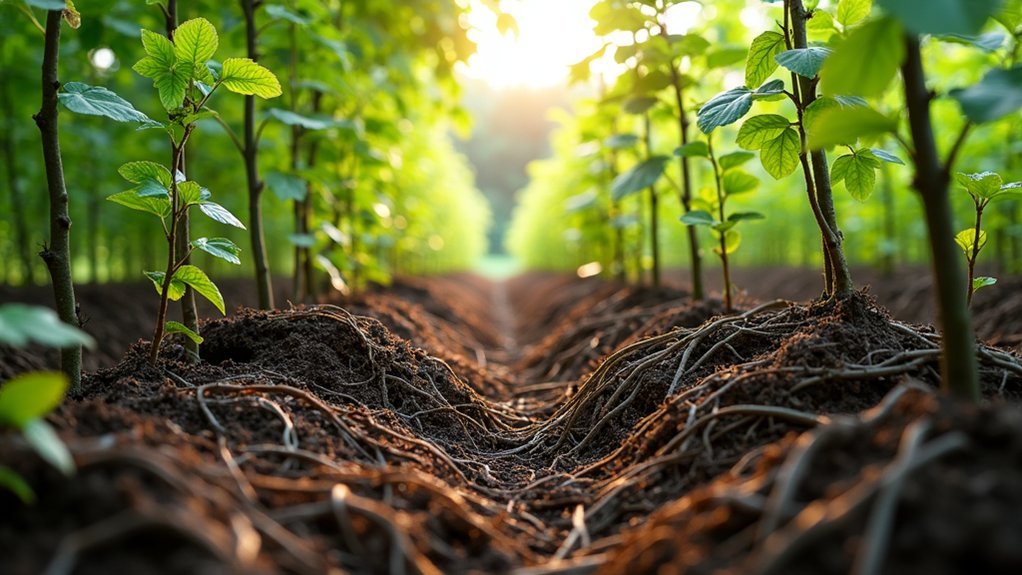Training roots when planting hedgerow fences creates stronger, more resilient barriers. You’ll benefit from improved drought resistance as deeper roots access hidden water sources, plus better erosion control through interconnected root networks. Properly trained roots establish faster, require less maintenance, and create denser hedges through strategic interweaving. Your hedgerow fence will also provide enhanced wildlife habitat and superior windbreak capabilities. The following techniques will transform your living fence into a self-sustaining ecosystem.
The Structural Benefits of Trained Root Systems in Hedgerows

Five critical benefits emerge when properly training root systems in hedgerow fences.
First, you’ll create superior erosion control as stabilized soil particles resist both wind and water damage. Dense networks slow runoff and capture sediment that would otherwise wash away. Properly established root systems can significantly reduce soil erosion potential in agricultural landscapes.
Second, you’re enhancing soil structure through root exudates that stimulate microbial activity and create vertical channels for water infiltration.
Third, you’ll establish natural filtration systems as fine root hairs trap contaminants while associated microbes break down pollutants.
Fourth, you’re ensuring long-term structural integrity by directing root growth away from foundations while promoting even nutrient distribution.
Finally, you’re protecting watersheds by stabilizing stream banks, regulating water temperatures, and creating natural buffers against agricultural runoff—all through strategically trained root systems.
How Root Training Creates More Drought-Resistant Hedgerow Fences
Beyond the structural advantages, root training directly impacts a hedgerow’s ability to withstand increasingly unpredictable weather patterns.
When you train roots to grow deeper, you’re creating a natural drought defense system that can access water sources unavailable to shallow-rooted plants.
Your hedgerows become more resilient through trained root systems that:
- Store considerably more water in their extensive networks
- Reduce water loss through better transpiration control
- Access deeper soil moisture during extended dry periods
- Adapt more effectively to your specific soil conditions
Plants with deep root systems can reach underground water sources that surface-rooted varieties simply cannot access during drought conditions.
This drought resistance isn’t just about plant survival—it’s about creating sustainable landscapes that require less maintenance and irrigation over time.
As climate patterns shift, your investment in proper root training will pay dividends through hedgerows that remain vibrant despite water stress.
Essential Soil Preparation Techniques for Healthy Root Development

You’ll need to double-dig your planting trenches to create loose soil that encourages deep, extensive root growth in your hedgerow fence.
Adding mycorrhizal fungi during planting establishes a beneficial relationship that extends the reach of your plants’ root systems and improves nutrient uptake.
Balancing your soil’s pH through appropriate amendments isn’t optional—it’s essential for ensuring your specific hedgerow species can access the nutrients they need for robust root development.
Consider sheet-mulching to prepare your planting area as this soil improvement technique helps suppress weeds while gradually enriching the soil for stronger root systems.
Double-Digging Enhances Growth
While many gardeners focus solely on aboveground hedge appearance, the foundation for a thriving hedgerow fence lies beneath the surface in properly prepared soil.
Double-digging creates the ideal environment for robust root development by breaking through compacted layers that would otherwise restrict growth.
When you double-dig your hedgerow trench, you’ll:
- Improve drainage and aeration critical for root respiration
- Mix organic matter deep into the subsoil where roots will access nutrients
- Eliminate hardpan barriers that prevent vertical root expansion
- Create 24+ inches of workable soil for long-term hedge establishment
This technique aligns with biointensive growing principles, supporting your hedge’s ability to develop extensive root systems.
The initial effort pays dividends through stronger plants, reduced maintenance needs, and hedges that establish faster with greater resilience against environmental stressors.
Creating small moats around plants helps manage water drainage and prevents root rot issues common in hedgerow plantings.
Mycorrhizal Fungi Benefits
Although often overlooked by novice gardeners, mycorrhizal fungi form a critical underground partnership with hedgerow plants that dramatically enhances their establishment and long-term vigor.
These beneficial fungi extend your plants’ effective root systems up to 100 times farther, accessing nutrients like phosphorus and zinc that would otherwise remain unavailable.
When you incorporate mycorrhizal inoculants during planting, you’ll see faster establishment, reduced transplant shock, and improved drought resistance.
The fungi penetrate deeper soil layers for water during dry periods and protect against root pathogens through competitive exclusion. Their hyphae also produce glomalin, which binds soil particles into stable aggregates, preventing erosion and improving aeration. The chemical excretions from these beneficial fungi can be toxic to nematodes and other soil pathogens that might otherwise damage your hedgerow plants.
This natural symbiosis reduces your need for synthetic fertilizers and irrigation while accelerating hedge density and vigor through enhanced nutrient cycling.
Ph Balancing Matters
Soil pH stands as the foundation of successful hedgerow establishment, directly determining whether your plants will struggle or thrive. Most hedgerow species prefer slightly acidic to neutral conditions (pH 6.0-7.0), where nutrients are most available for root development.
Before planting, you’ll need to test your soil and make appropriate adjustments:
- Add lime to raise pH in acidic soils, enabling roots to access crucial nutrients.
- Apply elemental sulphur to lower pH in alkaline conditions.
- Incorporate 4-6 inches of organic matter to buffer pH fluctuations.
- Thoroughly mix amendments throughout the topsoil to create a uniform root zone.
Don’t overlook pH-specific needs—plants like Rhododendrons require more acidic soil (below 5.8). Utilizing a reliable soil testing kit will provide accurate measurements to guide your amendment applications.
Proper pH balancing prevents nutrient deficiencies and toxicities while promoting vigorous root growth essential for hedge establishment.
Selecting Plant Species for Optimal Root Growth in Natural Fences

Choosing the right plant species forms the foundation of any successful hedgerow fence project. Native varieties like swamp crabapple and Western spiraea offer superior adaptability to regional climates, establishing roots quickly with minimal transplant shock.
Consider root architecture when selecting plants. Spiraea’s fibrous roots stabilize topsoil, while willow’s deep systems prevent erosion. For maximum resilience, combine shallow-rooted species (dogwood, ninebark) with deep-rooted options (willow, Osage orange). A mixed variety approach can significantly enhance both visual appeal and ecological benefits of your hedge.
You’ll get better results using small 1-2 gallon pots or bare-root plants planted during dormancy. Species like snowberry and dogwood naturally spread through root suckers, creating denser hedgerows over time.
For arid locations, drought-tolerant jujube produces edible fruit while developing robust root systems perfect for natural fencing.
Strategic Spacing Methods to Encourage Root Interweaving
You’ll create stronger natural barriers by planting your hedgerow species in zigzag patterns rather than straight lines, forcing roots to compete and interlock across multiple planes.
Staggered row systems maximize this interweaving effect by positioning each plant at the midpoint between two plants in the adjacent row, creating a dense root network that strengthens the entire fence structure.
These strategic spacing methods guarantee roots grow toward neighboring plants instead of outward, resulting in a living fence that gains structural integrity as it matures. Coppicing overgrown sections periodically will further promote dense growth at the base, preventing future gaps and maintaining the hedge’s protective function.
Zigzag Placement Patterns
Three key advantages make zigzag planting patterns superior to traditional straight-line hedgerows.
When you stagger plants in alternating positions across two rows, you’ll create a denser, more resilient hedge with interwoven root systems. This configuration enhances structural integrity while maximizing your available space.
Your zigzag-planted hedgerow provides multiple benefits:
- Creates effective windbreaks and noise buffers
- Prevents soil erosion through intertwined root networks
- Establishes diverse wildlife habitats supporting birds and insects
- Develops microclimate protection against frost and drought
For ideal results, plant five specimens per meter with approximately 50cm spacing between plants within rows and 40-50cm between rows. The diagonal spacing should increase by 25% compared to single row spacing for optimal growth and density.
Dig trenches rather than individual holes to guarantee uniform planting depth and reduce labor.
Remember that proper soil preparation with organic matter will greatly improve your hedge’s establishment success.
Staggered Row Systems
While zigzag patterns provide excellent density, staggered row systems take your hedgerow strategy to the next level by specifically promoting root interweaving. This arrangement distributes plants in offset positions between rows, creating ideal conditions for roots to naturally intertwine as they develop.
When implementing a staggered system, calculate your single row spacing first, then add 50% for the distance between rows. For double rows, position plants diagonally to maximize density without crowding. You can use a measuring stick at a 45-degree angle to guarantee uniform placement.
The real benefit comes below ground—roots grow outward and eventually form a complex network that strengthens soil structure, prevents erosion, and improves plant stability during harsh weather. This interweaving creates a stock-proof barrier that naturally protects adjacent fields without additional fencing requirements.
This interweaving also enhances the hedgerow’s function as wildlife habitat while improving soil health.
Root Pruning and Guidance Systems for New Hedgerow Plantings

Properly trained root systems form the foundation of a successful hedgerow fence, making root pruning essential during the planting phase.
When establishing your hedgerow, prune roots in late winter or early spring before new growth begins, using sharp tools to make clean cuts.
For best results, size your root ball according to the trunk caliper—typically 8-12 inches of radius per inch of diameter. This prevents future problems while promoting fibrous root development in your hedge plants. Remember that cutting roots that are over one inch in diameter can cause significant problems for the plant’s health and stability.
- Use the spading technique for smaller shrubs, cutting just inside the intended root ball
- Apply the trenching method for mature trees with a 12-inch wide by 12-inch deep trench
- Backfill with topsoil-compost mix to encourage new feeder root growth
- Water deeply post-pruning to maintain moisture 2-3 inches below soil surface
Preventing Common Root Development Problems in Living Fences
Root circling can choke your living fence before it ever establishes, while unchecked root invasion might create tension with neighbors or damage nearby structures.
You’ll need to incorporate root barriers or guidance systems during planting to direct growth patterns and prevent these common issues. Installing barriers is particularly important when planting red cedar trees, as their root systems extend well beyond their canopy width.
Regular soil aeration and avoiding foot traffic near your hedgerow will combat compaction that restricts root expansion and nutrient uptake.
Root Circling Prevention
In the domain of hedgerow fence establishment, preventing root circling stands as a critical concern for long-term viability.
When roots circle due to confined growing spaces, they can eventually strangle your plants, compromising the entire hedgerow structure.
To prevent root circling in your living fence, implement these proven strategies:
- Guarantee adequate soil volume for each plant’s natural root development
- Install root barriers 5-10 feet deep to redirect growth in desired directions
- Space plants properly to allow sufficient room for root expansion
- Use proper planting techniques with correct depth and soil conditioning
Incorporating fast-growing species like Hawthorn and Osage Orange provides quicker establishment while allowing proper root development.
Regular maintenance and deep watering encourage roots to grow downward rather than circling.
Restricting Invasive Spread
Controlling invasive root spread presents the next challenge after preventing root circling in your hedgerow fence. To manage this effectively, you’ll need a combination of strategic approaches.
Install physical root barriers made of polypropylene or HDPE before planting to contain root development within designated boundaries.
Select species with naturally manageable root systems, such as yew or boxwood, particularly in areas near infrastructure or neighboring properties.
Implement regular pruning during dormant seasons to redirect plant energy and control underground growth patterns. This practice not only maintains your fence’s aesthetic but limits unwanted root expansion.
Avoid planting species with incompatible root requirements side by side, guarantee proper drainage, and maintain balanced irrigation. Maintaining a 10ft distance between your hedgerow and crops will prevent unwanted competition for nutrients and sunlight.
With these preventative measures, you’ll create a hedgerow fence that remains in its proper place without invading surrounding areas.
Soil Compaction Solutions
Compacted soil presents a significant obstacle for hedgerow fence establishment, potentially stunting root development and compromising the entire living structure.
You’ll need to address compaction before and after planting to guarantee your hedgerow thrives.
Begin with proper site preparation using subsoiling or broadforking to break up compacted layers, especially in clay soils. The use of a Yeomans keyline plow can be particularly effective for breaking up historical compaction issues.
After planting, manage compaction with these proven techniques:
- Install designated walkways and barriers to redirect foot traffic away from root zones
- Add organic matter like compost to improve soil structure and porosity
- Implement regular root pruning to encourage healthy growth patterns
- Create micro-basins around plants to enhance water infiltration
These solutions will improve water penetration, increase biodiversity, enhance root systems, and reduce erosion risks—ultimately creating a more stable and effective living fence.
The Long-Term Maintenance Plan for Trained Root Systems
Once you’ve established your hedgerow fence with properly trained roots, maintaining their health becomes essential for long-term success. Regular trimming every 1-2 years prevents overgrowth while promoting healthy root development beneath the soil.
Keep the area around your hedgerow weed-free to eliminate competition for nutrients and regularly inspect for signs of waterlogging or erosion that might compromise root stability.
A thriving hedgerow demands vigilance—clear weeds, check drainage, and prevent erosion to safeguard your living fence’s foundation.
Apply appropriate fertilizers to guarantee your soil provides sufficient nutrients for peak root health.
Don’t forget to monitor for pests that could damage your carefully trained root systems. Install tree guards or fencing if grazing animals pose a threat.
For older hedgerows, consider rejuvenation techniques like hedgelaying or coppicing to stimulate new growth from the base while maintaining the established root structure.
Seasonal Considerations for Root System Management

The rhythm of seasons profoundly impacts your hedgerow’s root development, with each period offering unique opportunities for management.
Begin planting in early winter on drier sites to extend root establishment, but delay until late winter in wetter areas to prevent rot.
Fall preparation sets the stage for spring success.
Apply compost as mulch or plant cover crops to improve soil structure while utilizing autumn’s natural conditions to prime roots for growth.
During summer’s heat, focus on these survival essentials:
- Provide 2-3 deep waterings weekly for first-year plants
- Maintain 5-10cm organic mulch to regulate soil temperature
- Avoid nitrogen fertilization that prioritizes foliage over roots
- Remove weeds manually to protect shallow feeder roots
Autumn is ideal for moderate pruning and soil testing before winter dormancy.
Measuring Success: Signs of a Well-Established Root Network
While seasonal management builds the foundation for healthy hedgerows, gardeners need reliable indicators to confirm their efforts are yielding results below ground.
You’ll know your hedgerow’s root system is thriving when you observe robust shoot growth and vibrant leaf color throughout the growing season.
Watch for your hedgerow’s increasing resilience to environmental stressors—established plants will withstand drought conditions with minimal wilting and recover quickly after severe weather events.
A thriving hedgerow speaks through resilience—bouncing back from drought and storms while lesser plantings struggle.
Deep, spreading roots manifest as improved stability; newly planted specimens that once swayed in moderate winds will stand firm once properly anchored.
The surrounding ecosystem also reveals root health: increased soil insect activity, improved moisture retention, and reduced erosion around the hedgerow base all indicate successful root establishment.
These signs collectively confirm your root training practices are creating the foundation for long-lasting, functional hedgerow fences.
Frequently Asked Questions
How Long Does It Take for Trained Roots to Fully Establish?
Your trained roots typically take 2-3 years to fully establish. You’ll notice they’re established when they no longer need regular watering and show strong growth even during challenging weather conditions.
Can I Train Roots in Existing Mature Hedgerows?
Yes, you can train roots in mature hedgerows through selective root pruning, soil cultivation, and applying growth enhancers. It’s challenging but possible with careful techniques, though you’ll need patience as mature roots respond slower than young ones.
Are There Chemical Treatments That Enhance Root Development?
Yes, you can use auxin-based root stimulators, phosphorus-rich fertilizers, seaweed bio-stimulants, or chelated micronutrients to enhance root development in your hedgerows. Apply during spring or early summer for best results.
How Do Trained Roots Interact With Underground Utilities?
Trained roots grow more predictably around utilities. You’ll prevent costly damage by directing roots downward with barriers. They’re less likely to infiltrate pipes or cables when you’ve established controlled growth patterns from planting.
What Wildlife Benefits From Well-Trained Hedgerow Root Systems?
Well-trained hedgerow roots support diverse wildlife by creating habitats where you’ll find birds nesting in dense vegetation, mammals using safe travel corridors, and pollinators thriving year-round, while also stabilizing soil for microhabitat development.
In Summary
You’ll find that training your hedgerow’s root systems creates living fences that last decades, not years. By investing time in proper root development now, you’re ensuring stronger drought resistance, improved stability, and natural interweaving that strengthens the entire structure. Don’t skip this vital step—your future self will thank you when your hedgerow stands firm through extreme weather, requires less maintenance, and provides reliable boundary protection year after year.





Leave a Reply